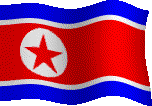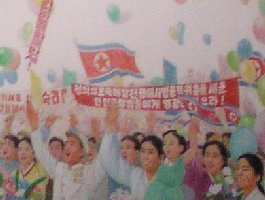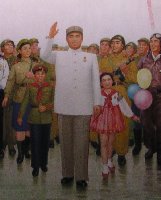






Day 2: Kaesong Needs The Light Of The Great Leader
View from Juche Tower - by Adrian Tute
At
6am, we were woken up by revolutionary music calling the people to get up to
work for the glory of the Nation. Communist
countries have an efficient way of dealing with alarms – they simply set a
common alarm for everyone. I
remember being woken up by similar music in Chengdu, China, in 1995.
I believe that has disappeared in most of China now but I guess Pyongyang
is a different world.
We
began the day on a “pilgrimage” to Mangyongdae, the birthplace of Kim Il
Sung 12km from Pyongyang city centre. Welcome
to the Mecca of Kimilsungism!
As
our bus rolled along the highway towards Mangyongdae, we passed thousands of
adults and school children, on the way to Mangyongdae as well.
They waved red flags and branches of pink and red flowers, the
Kimilsungia and Kimjonlia respectively, walking to the “sacred” ground like
pilgrims do, sometimes singing patriotic songs along the way. Some saluted as we passed them.
It was amazing sight. How
many people have they mobilised to pay tribute to the Benevolent Sun and Sun of
the 21st Century?
Mangyongdae
- This group of thatched huts is one of the most sacred spots for the
worshippers of the Kim’s. According to official account, Kim Il Sung was born here in
1912, in a family so poor that his mother bought a huge damaged jar to hold
water. This pathetically punctured
jar was a proof of the family’s poverty and yet, one might question how a poor
family managed to have so many family photos taken in that era.
The
huts displayed photos of many members of Kim Il Sung and his extended family,
most of whom, according to official accounts, were martyrs of the struggle
against the Japanese occupation of Korea. At
the age of 13, he left home to fight the Japanese, and founded the forerunner
organisation of the ruling Workers’ Party of Korea at the age of 14. He was a great guerrilla leader in the deep mountains by 24
and liberated the country from the Japanese in 1945, when he was 33!
What a child prodigy, master strategist and brilliant general!
That is, if you believe in all that.
South
Korean, American and Russian sources are less flattering.
They say he was a refugee in neighbouring Northeast China, later fled to
Russia as the Japanese nearly wiped out the guerrillas.
It was in a Russian camp where his son, Kim Jong Il (Kim Jong Il) was
born, although DPRK official accounts claim that Kim Jong Il was born on sacred
Mt Paektu, the Korean mountain of the Gods, on the day a bright star and double
rainbow appeared over the skies.
----
The
DPRK is a nation of political symbolism, as well as blatant propaganda. The tourist will no doubt become familiar with the usual
barrage of these symbols. Here’re
some of the most common ones apart from images of the Kim Il Sung and Kim Jong
Il:
-
Flowers named after Kim Il Sung and Kim Jong Il, Kimilsungia and
Kimjonglia.
-
Mangyongdae, birthplace of Kim Il Sung.
-
Mt Paektu, tallest mountain of Korea
-
The Chollima horse.
Political
banners are everywhere, with slogans such as: “Long Live The Great Leader!
“Long Live the Ideas of General Kim Il Sung!” “President Kim Il Sung Lives
Eternally In Our Hearts!” “Long Live The Sun Of The 21st Century,
General Kim Jong Il!” “Drive Out American Imperialists & Reunify The
Country!” “Crush The Nuclear Provocations of the US Imperialists!”
----
 Back
in Pyongyang, we visited the other gigantic monuments to the country’s leaders
and ideology, such as the Juche Tower and Monument to the Party Foundation.
Pyongyang is a city of monuments. Many
of these tall, monuments were built in symmetrical patterns to also fit in with
other grand public buildings with incredible straight-line views across the
city. It was as though the two Kim’s were also feng shui experts
and urban planners in addition to other skills they are renowned for.
How I would love to have them rule the whole world!
Back
in Pyongyang, we visited the other gigantic monuments to the country’s leaders
and ideology, such as the Juche Tower and Monument to the Party Foundation.
Pyongyang is a city of monuments. Many
of these tall, monuments were built in symmetrical patterns to also fit in with
other grand public buildings with incredible straight-line views across the
city. It was as though the two Kim’s were also feng shui experts
and urban planners in addition to other skills they are renowned for.
How I would love to have them rule the whole world!
We
also visited the Pyongyang Metro. As
one descended on the amazingly long escalators, loud military music and
exclamations over the radio system called on the commuter to “work for our
strong country under the guidance of the party and the ideals of Great Leader
Kim Il Sung”.
Inside,
beautiful mosaic showing the Great Leader in various poses, in his long grey
coat with the usual trinity of the worker, peasant and soldier, not to mention
other standard DPRK icons such as Mangyongdae, the Chollima horse and Mt Paektu.
It was like time travel to Moscow during Stalinist days or Beijing under
Mao Zedong.
One
grand structure that we saw was the pyramid-shaped 105 storeys’ Ryugong Hotel,
which was never completed. It was
intended to be the world’s tallest hotel with five revolving restaurants on
top (for unknown reasons, this country loves revolving restaurants!), though one
wanders why they need all those rooms when DPRK gets so few visitors.
However, the Russians messed up the job and construction stopped in 1992.
It was said that the lift is now listing dangerously and could collapse
any moment.
More
than a decade since construction was interrupted, the empty shell of the 330
meters’ structure has remained the most obvious landmark of the city, visible
from anywhere in the city and suburbs, and most certainly, a symbol of the
monumental “success” of the regime.
----
 Have
you heard of this term “on-the-spot guidance”?
The Great Leader and Dear Leader are pioneers of this term, which
basically means them as supreme leaders of the country and genius of humankind,
giving advice and guidance on one and everything under the sun.
Such advice are duly documented and plaques or monuments put up on the
spot to commemorate such guidance, which could range from anything from choice
of water taps for public housing projects to fish farming and furniture design.
Have
you heard of this term “on-the-spot guidance”?
The Great Leader and Dear Leader are pioneers of this term, which
basically means them as supreme leaders of the country and genius of humankind,
giving advice and guidance on one and everything under the sun.
Such advice are duly documented and plaques or monuments put up on the
spot to commemorate such guidance, which could range from anything from choice
of water taps for public housing projects to fish farming and furniture design.
This CNN report provides some
interesting examples of the leaders’ on-the-spot guidance activities:
Kim talks food and fashion
From
Senior Asia Correspondent Mike Chinoy
(CNN)
--It is a safe bet that television viewers in North Korea will not hear much
about upcoming talks in Beijing aimed at curbing the secretive nation's nuclear
ambitions.
That's
because in his reclusive regime, prime time fare features only one character --
leader Kim Jong Il.
For
those lucky enough to have access to a television, on a recent evening part six
of "The Legend of Blossoming Love for On The Spot Guidance" was
screening.
In
this episode the mysterious Kim, who is otherwise known as the "Great
General," the "Dear Leader," and the "Peerless
Patriot," showed he was a man of the people.
"From
east to west, north to south, the Great General travels the country," the
announcer intones.
"You
warm us like the sun. Have you ever served a Great Leader like this?"
The
god-like Kim is also seen providing what the North Koreans call "on the
spot guidance" to the armed forces. The message is clear enough -- the
one-million-man army is Kim's main power base.
In
a country where most people go hungry, the Dear Leader - with a fondness for
fast cars and fine dining - is seen giving advice on nutrition and inspecting
mountains of food destined for the troops.
According
to the announcer, Kim tells the troops "there's nothing I wouldn't spare
for my soldiers. Behind every great general is a great army."
But
Kim's wise words are not limited just to food. For the female soldier, the Great
General provides a karaoke machine and tips on how to use it.
'We're
so lucky," the announcer says "to be loved by him."
There's
also some "on the spot guidance" in the fashion department from the
man who is rarely ever photographed wearing anything but his grey-green suit.
"All
these uniforms," the announcer declares, "were made with the love of
the Great Leader," who wants to be sure the colors match and the jackets
are warm enough.
And
because Kim wants to keep his soldiers healthy, there's some guidance about how
to brush your teeth.
For
their loyalty, there are free TV sets all around. The ecstatic troops dance in
the snow, no doubt eager to tune in for part seven.
|
|
|
|
|
||||||||||
|
|
|
|
|
The
Great Leader and Dear Leader are renowned geniuses hardly matched in world
history. The North Korean people as
well as world civilisation have benefited from their great works in politics,
history, philosophy, military-strategy, economics, nuclear science, aeronautics,
electronics, culture, and film-making, among countless other topics.
North Korean undergraduates use textbooks written by the two leaders on
mathematics, physics, chemistry, computer science, biology, geography and
history.
According
to a KCNA report, “the respected Dear Leader is a genius well versed in the
latest science and technology. He
gave on-site guidance to the Academy of Sciences and other scientific research
institutes and gave clear-cut instructions on scientific and technological
problems which even specialists could hardly understand.”
The
report continued, “When an institution developed a new world-level programming
system, he personally operated a computer to learn its level, stated its
shortcomings and clearly indicated the ways for overcoming them.”
The
two leaders are also authors to all-time best-selling literature works and
winner of major literary awards. In
fact, Kim Jong Il was known to have written 1500 books during his university
days, that is, more than one book per day.
The
Dear Leader is also said to be an accomplished rocker, singer and composer,
although the only public recording of his voice any foreigner could find was
made during a 1992 military parade, when he said, “Long Live the heroic Korean
People’s Army!”
According
to the local press, “famous” actors, actresses, acrobatic troupes and
artists from forty countries worldwide have arrived in Pyongyang to the
“Spring Friendship Arts Festival to celebrate Day of the Sun”, Kim Il
Sung’s birthday. We have met some
of these people in our hotel, including Mainland Chinese, Russians, Indonesians,
Vietnamese, Finns, Indians, Japanese, Uzbeks, Syrians, Egyptians, Zimbabweans
and even Korean-Americans. “The
whole world is celebrating the glories of Kim Il Sung and Ideas of Juche,” the
North Korean press noted.
|
|
|
|
|
We
drove south to Kaesong, capital of the Koryo dynasty (932 – 1389 A.D.), across
flat agricultural plains and rolling hills.
This was a straight highway with hardly any vehicle.
We took three hours to reach Kaesong, a provincial capital with more than
300,000 people. Here, Panmunjom on
the Demilitarised Zone (DMZ) was only 8km away.
Kaesong
is the site of a special economic zone that is being developed with Hyundai
Corporation of South Korea. Here,
Hyundai and other South Korean companies will set up factories employing cheap
labour from North Korea. This is a
major step towards cooperation between the two Korean states, and one that would
help the South Koreans to compete effectively with the growing economic prowess
of China.
Tourists
come to Kaesong for two things – the ancient relics of the Koryo dynasty and
Panmunjom. Upon arrival, we headed
for the royal tombs of King Wan Kon, the first king of Koryo.
Koryo, according to DPRK, was the first unified Korean dynasty.
King Wang Kon had united the remnants of the Koguryo (spelled Goguryeo in
the South) kingdom with the much-weakened Silla kingdom of the south.
South
Korean and international historians, however, say that Silla was the first
unified dynasty of Korea. Based in
the South Korean city of Gyeongju, Silla united the country after the defeat of
Koguryo and Paekche. Modern
political considerations often affect the interpretation of history.
The North Koreans often emphasised the importance of Koguryo and Koryo
because their capitals were in the north, whereas the South Koreans emphasised
Silla and Ri Dynasty because their capitals were in the south.
As with the royal tombs of Silla at Gyeongju, the tomb of Wang Kon was a huge round mound surrounded by carvings of the twelve Chinese zodiac animals as well as sculptures of officials and generals. Looking at how “new” the sculptures were, it seemed that the North Koreans had completely reconstructed the tomb complex after its destruction during the Korean War.
|
|
|
|
|
We
drove back to town where we put up at the Kaesong Folk Hotel.
This comprises of traditional Korean houses and courtyards converted into
a hotel complex in the middle of Kaesong’s wonderfully preserved old town of
narrow alleys, square compounds and quaint old houses.
To
protect honoured tourists from the harassment and dangers of excessive
interaction with residents of the old town, our beloved Dear Leader has turned
entire area of the old town into the Folk Hotel, where tourists can stay in the
traditional old houses and wander on a few short alleys within the walled
confines of the hotel along a picturesque stream, without ever stepping onto the
open streets of Kaesong.
Dear Leader further pampered us with a
wonderful traditional Korean dinner specially prepared in the traditional
fashion, and we were asked to join the fun, such as crushing soya beans, milling
the flour, etc. It was a wonderful
evening, where we indulged in lots of fun and laughter with the hospitable staff
of the Folk Hotel.
We walked back to our room after the dinner. It was pitch dark as the country faced serious power shortages. The only source of brightness, however, was the brightly lit golden statue of Kim Il Sung overlooking the city. Yes, give me the light of the Great Leader!
Buy these books!
| Kim Jong-il : North Korea's Dear Leader (Michael Breen) | North Korea: The Bradt Travel Guide (Robert Willoughby) | Lonely Planet Korea (Korea, 5th Ed) (Robert Storey) |
|
Copyright - Tan Wee Cheng, Singapore, 2004 |